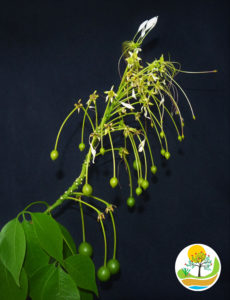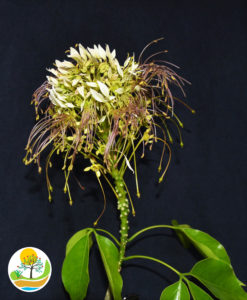General information
Summary description
Crataeva tapia is a tree species found in the Brazilian semiarid region in the Caatinga vegetation of crystalline-rock areas, in sedimentary areas, and in riparian forests. It belongs to the Order Brassicales, Family Capparaceae (LORENZI, 2008; APG III, 2009; MORO, 2014).
Scientific nomenclature
It is scientifically named as Crateva tapia L. (TROPICOS, 2017), but it is also mentioned as Crataeva tapia L. in the literature (CNIP, 2017). In Cronquist (1981), a natural system of classification, the Traipá belongs to Subclass Dilleniidae and Order Capparales. But in the most recent classification (APG III, 2017), based in phylogenetic characteristics, this is species is grouped within the Class Equisetopsida, Subclass Magnoliidae Nová ex Takht, Superorder Rosanae Takht, Order Brassicales Bromhead, Family Capparaceae Juss, and Genre Crateva L.
Local names
Trapiá, Cabaceira, Cabaceira-de-pantanal, Pau-d’alho, Tapiá, Breu branco, Catoré, and Catauarizeiro (NEVES, 2013; LORENZI, 2008; CAVALCANTE, 2014; MACHADO et al., 2016).
Cultural and economic importance
The Trapiá (Crateva tapia L.) is used in beautification projects and reconstitution of degraded areas, and its fruits are used to make beverages (juice and wine drinks) (LORENZI, 2008). Leaves and bark are used in popular medicine to treat diabetes, itchiness and muscle pain (CAVALCANTE, 2014). Its wood, with moderate density (.56 g/cm³), may present crackings when drying out, and low durability. For these factors, it is locally used for small constructions, in ceilings, boxes, and canoes (LORENZI, 2008).
Ecological importance
In a study made by Cavalcante (2014), the species presented a high rate of stomatal conductance in conditions of hypoxia due to soil flooding, indicating high tolerance to this factor. The same author mentions that, during rainy seasons, C. tapia in lowland presents high stomatal conductance in response to high irradiance, suggesting that it has a better ecophysiological performance. On the other hand, the same species show low tolerance to water stress in dry periods (CAVALCANTE, 2014). In summary, C. tapia presents variable physiological plasticity in the process of stomatal conductance as a result of variations in seasonal periods and topographic distribution.
Geographical distribution
Native from Brazil. However, it isn’t endemic of Brazil and occurs in Mexico, Honduras, Guatemala, Equador, El Salvador, Nicaragua, Panama, Colombia, Venezuela, Peru, and Argentina 9CORNEJO and ILTIS, 2008). According to Forzza (2010) it is present in the North (states of Acre, Amazonas, Amapa, Para, Rondonia, Roraima, and Tocantins), Northeast (states of Alagoas, Bahia, Ceara, Maranhao, Paraiba, Pernambuco, Piaui, Rio Grande do Norte, and Sergipe), Med-West (Federal District, states of Goias, Mato Grosso do Sul, and Mato Grosso); Southeast (states of Espirito Santo, Minas Gerais, Rio de Janeiro, and Sao Paulo); and South (states of Parana, Rio Grande do Sul, and Santa Catarina) regions, and also in Abrolhos, Fernando de Noronha, and Trindade (oceanic islands). As for the phytogeographic domains the species is present in the Amazonia, Caatinga, Cerrado, Mata Atlantica, Pampa, and Pantanal (FORZZA, 2010).
Botanic description
Vegetative characteristics
- Trunk and bark
According to Lorenzi (2008), Trapia’s tree reaches 5 to 12 m (16.4 to 39.4 ft) in height. Round and dense crown, with cylindrical trunk generally tortuous and 20-40 cm (7.87 to 15.7 in) in diameter. Its bark is brownish and rough (LIMA, 2012).
- Leaves
Trifoliate leaves (the only Capparaceae plant registered in Brazil with this characteristic) (NETO and JARDIM, 2015). It has a 6 to 12cm-long petiole (2.36 to 4.72 in) (LORENZI, 2008). Spiral alternate leaves with no stipule, ovate of elliptical leaf blade, with acuminate top or cuspidate, obtuse base, entire margin (NETO and JARDIM, 2015).
- Flower/inflorescence
Axillary or terminal raceme. Sepals of 3 to 5 mm, lanceolate, glabrous, with basal nectaries. White unguiculate petals (NETO and JARDIM, 2015). Hermaphrodite flowers, or few masculine flowers at the top of the raceme.
- Fruit, seeds and dispersal syndrome
The fruit is a berry, globous or subglobous, yellow, peduncle of 4 to 5 cm (1.6 to 2 in) in length.
Solitary seed, dark brown, curved (in a way that the top touches the base almost forming a circle) (LIMA, 2012). According to Lorenzi (2008), trees of C. tapia flower in the dry period (August to November) and its fruits ripen in the transition from dry to rainy season (January to May). But Neto et al. (2014) affirm that the species present flowers and fruits in January, July, and from September to December.

Fruits of Crataeva tapia.
< Go back to main page >
REFERENCES
- APG III. Angiosperm phylogeny. Available in <http://www.mobot.org/MOBOT/research/APweb/>. Access 6 mar. 2017.
- CAVALCANTE S. C. Ecossistema de várzea: etnobotânica e ecofisiologia. Dissertation (Masters in Natural Resources of Amazinia) Universidade Federal do Oeste do Pará, Pará. 2014.
- CORNEJO, X.; ILTIS, H. H. A revision of the american species of the genus Crateva (Capparaceae). Harvard, Papers in Botany, v. 13, n. 1, p. 121-135, 2008.
- FORZZA, R. C. Introdução. in: Lista de Espécies da Flora do Brasil. Jardim Botânico do Rio deJaneiro. Available in <http://floradobrasil.jbrj.gov.br/2010>
- LIMA, B. G. de. Caatinga espécies lenhosas e herbáceas.1ª. ed. Mossoró: EDUFERSA editora universitária, 2012. v. 3000. 316p .
- LORENZI, H. Árvores brasileiras: manual de identificação e cultivo de plantas arbóreas do Brasil. Nova Odessa. Plantarum. 5 ed. 384 p. 2008.
- MACHADO, J. R. A.; SILVA, N. G.; DUARTE, C. C. Biodiversidade florística ameaçada pelo uso intensivo de pastagens, no município de Palmeirina – PE. REGNE, vol. 2, n. Especial, 2016.
- MORO, M. F. et al. Vegetação, unidades fitoecológicas e diversidade paisagística do estado do Ceará. Rodriguésia, Rio de Janeiro , v. 66, n. 3, p. 717-743. 2015.
- NETO, R. L. S.; JARDIM, J. G. Capparaceae no Rio Grande do Norte, Brasil. Rodriguésia, Rio de Janeiro, v. 66, n. 3, p. 847-857, 2015 .
- NEVES, R. B. Caracterização das reservas das sementes e avaliação da germinação e formação de plântulas de nove espécies arbóreas de florestas alagáveis da Amazônia. Dissertation (Masters in Botany). Universidade de Brasília, DF. 2013.

